Attracting the right leads is a constant challenge, particularly for manufacturers with complex, high-value products.
Generic content might generate traffic, but it often fails to bring in qualified prospects who understand the true value of what you offer.
Without the right sales tools and resources aligned with your content, your sales team can end up wasting time on leads that don’t convert.
This guide will show you how combining content marketing with sales enablement can help manufacturers attract the right buyers, streamline the sales process, and close deals faster.
What is Content Marketing vs. Sales Enablement?
Content marketing and sales enablement are two distinct but complementary strategies.
Understanding the difference, and how they can work together, will help you build a more efficient and effective sales process.
Content Marketing
Content marketing is the process of creating valuable content to attract, engage, and educate potential customers. It can include blog posts, videos, social media updates, and more.
Sales Enablement
Sales enablement is about equipping your sales team with the tools, content, and training they need to engage with prospects effectively and close deals faster.
This can include product information, case studies, and sales playbooks.
To further enhance your understanding of sales enablement and its significance in the sales process, watch the following brief video:
[Embed the video here]
This visual guide will provide a quick yet comprehensive overview, helping to solidify the concepts discussed.
Why They Work Together?
Content marketing nurtures leads by educating and informing them, while sales enablement gives your sales team the right tools to convert those educated leads into paying customers. Together, they form a powerful, efficient sales process.
The Sales Funnel: Tailoring Content to Every Stage of the Buyer’s Journey
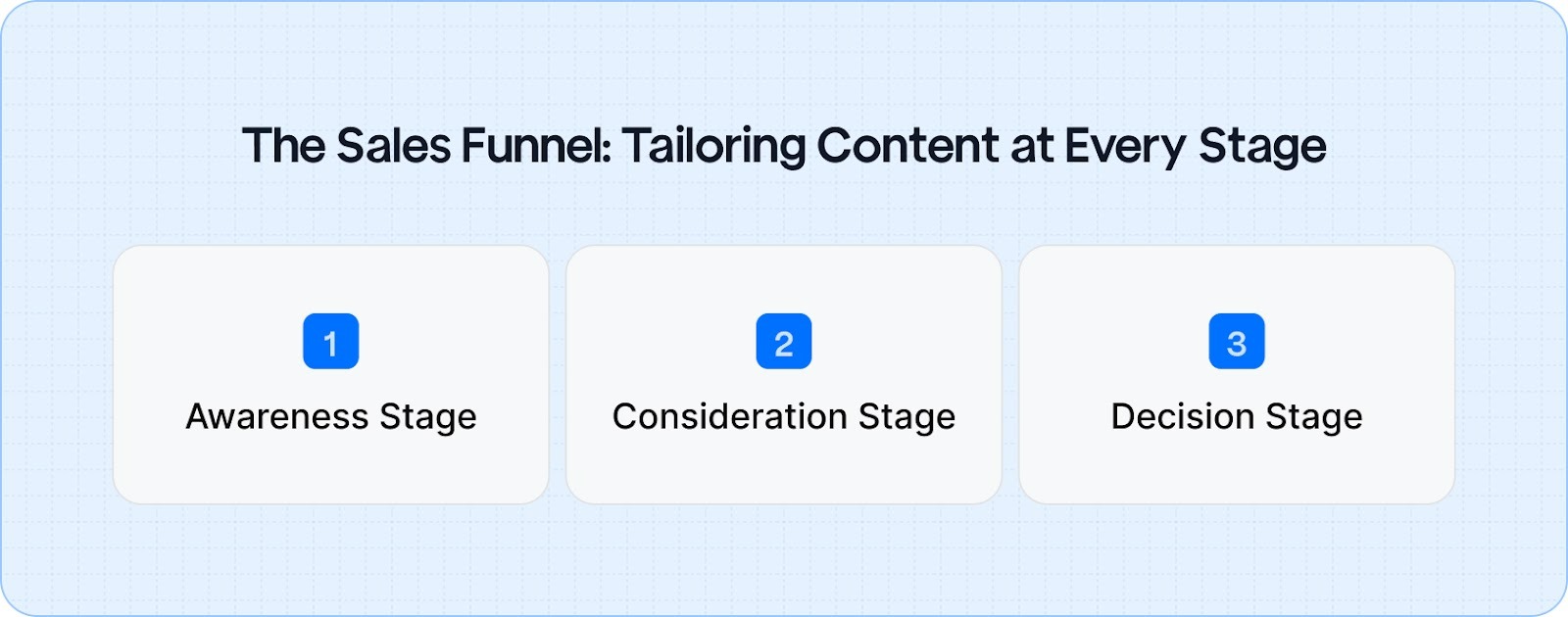
The sales funnel is the process a potential customer follows before making a purchase. It starts with them realizing they have a problem and ends with them deciding to buy a solution.
Each stage of the funnel requires different types of content to guide the customer along the way.
1. Awareness Stage
In this stage, prospects are becoming aware of their problem and searching for solutions. Your goal is to educate them about their challenges and introduce your product as a possible solution.
- Content types: Blog posts, social media updates, introductory videos
- Purpose: Help prospects realize their pain points and that a solution exists
- Example: A blog post that explains how inefficient equipment leads to higher production costs, subtly introducing your product as a fix.
2. Consideration Stage
At this point, prospects know their problem and are considering options. You need to show them why your product is the best choice to solve their problem.
- Content types: eBooks, webinars, in-depth case studies
- Purpose: Provide valuable insights and comparisons to help prospects evaluate their options
- Example: A webinar that shows the specific benefits of your product, or a case study demonstrating how it improved efficiency for a similar business.
3. Decision Stage
Now, prospects are ready to decide. They just need the final pieces of information to make the purchase. This is where your product-specific content comes in.
- Content types: Product demos, customer success stories, pricing guides
- Purpose: Convince them that your solution is the right one, providing clear proof of its value
- Example: A product demo video or a detailed pricing guide that clearly shows how affordable and effective your solution is compared to others.
Sales Enablement Integration
Your sales team plays a key role in guiding prospects through these stages. Sales enablement content, such as battlecards (quick reference guides), product sheets, and pitch decks, help your team answer questions and provide the right resources at each stage of the buyer's journey.
- Tools for your sales team: Quick reference guides (battlecards), one-pagers (product sheets), tailored presentations (pitch decks)
- Goal: Ensure your sales team has the right content to close deals efficiently at every stage.
A Reddit thread from the r/ProductManagement community highlights valuable insights on creating effective sales enablement materials.
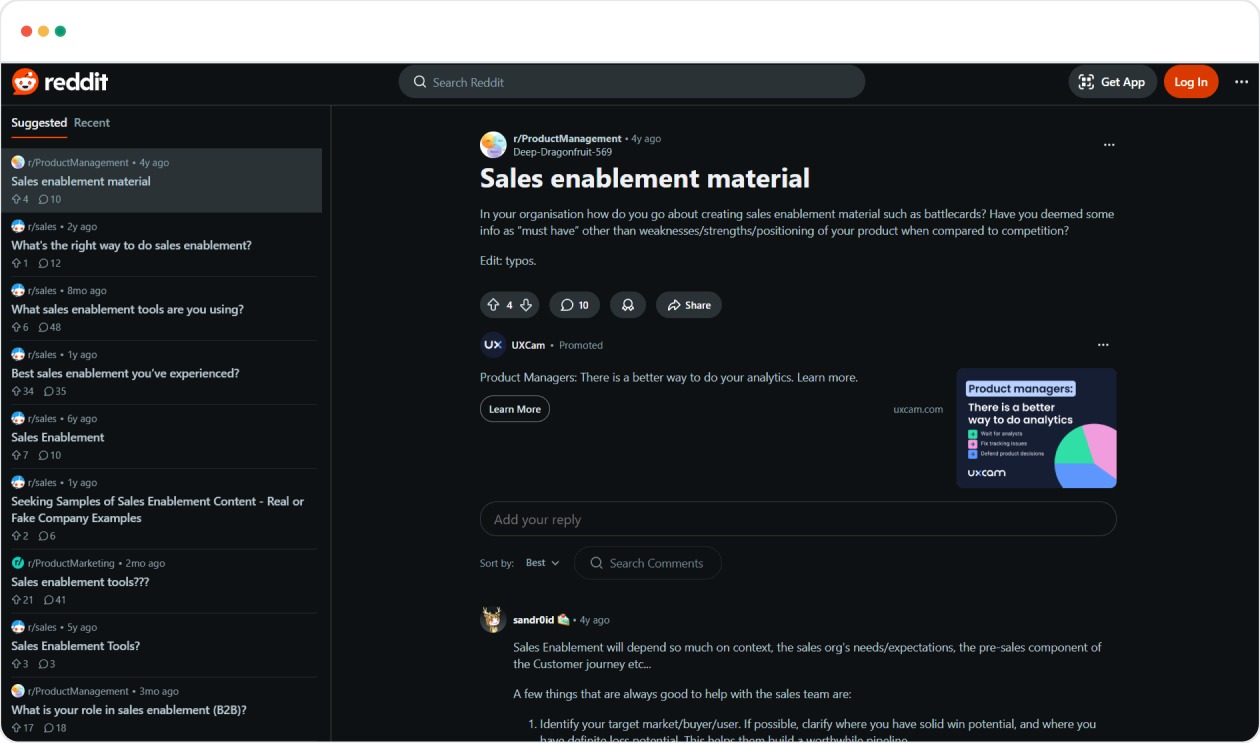
The thread also points to useful tools and strategies, which ensures that sales teams can quickly find the answers they need.
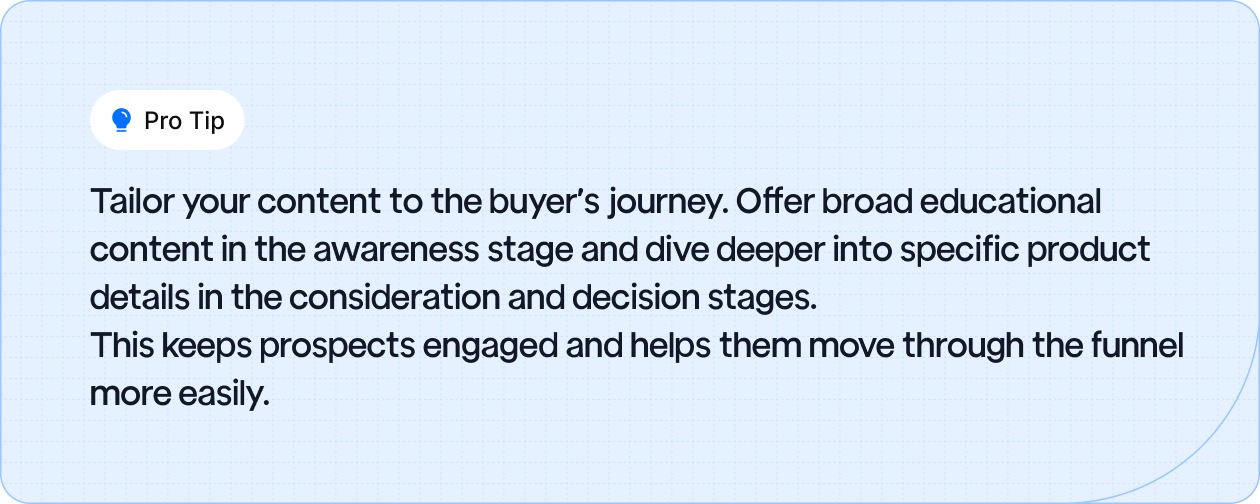
The Synergy Between Content Marketing and Sales Enablement
In many businesses, marketing and sales teams work separately, each focusing on their own goals.
But for manufacturers, especially those with complex products, success comes when both teams collaborate closely.
When marketing and sales are aligned, they create a seamless experience for the prospect, guiding them smoothly from the first interaction to the final sale. Without this partnership, leads can get lost, and valuable opportunities are missed.
How they work together:
Content Creation
Marketing’s job is to create content that raises awareness and attracts potential customers. This includes blog posts, social media updates, videos, and more. But attracting leads is just the first step.
Sales teams take over to nurture these leads and move them through the buying process using the content marketing team has provided. Think of marketing as the "first impression," and sales as the "closer."
Example: Marketing creates a blog post explaining the benefits of your product’s energy efficiency, while the sales team uses that content in follow-up emails to further educate leads and answer specific questions.
Feedback Loops
For content marketing to be truly effective, sales teams need to provide feedback on what content works, and what doesn’t.
If a particular blog or video helped close a deal, marketing needs to know so they can create more content like it. This feedback loop ensures that both teams are continuously improving their strategies.
Example: Sales may tell marketing that prospects love detailed case studies, leading marketing to create more of these success stories to help close deals.
Sharing Knowledge
Collaboration tools, like CRM systems and shared content libraries, are vital for aligning marketing and sales. These tools make it easy for both teams to access and share the right content at the right time.
When marketing and sales have access to the same up-to-date resources, they can move leads through the funnel more effectively, ensuring that no valuable information is lost.
Example: Both teams can use a shared library to access product demos, pricing guides, or competitive battlecards, ensuring that sales reps are always using the most relevant and accurate content during conversations with prospects.
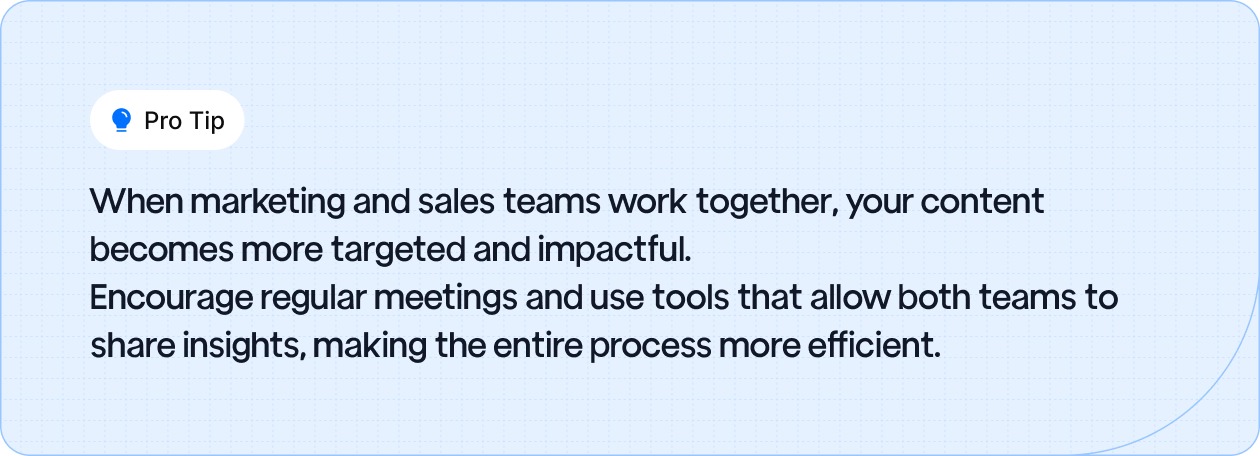
Key Types of Content for Sales Enablement
Sales enablement content refers to all the resources your sales team uses to engage with customers effectively and close deals. These materials help salespeople educate, persuade, and move prospects through the buying process.
Examples of sales enablement content include:
- Product sheets that provide essential details about your product’s features and benefits
- Demos that show your product in action, giving prospects a hands-on experience
- Case studies that highlight real-world examples of how your product has solved problems for other companies
1. Internal Sales Content
Internal sales content helps your sales team become more knowledgeable and efficient in their roles. These resources prepare your team to have confident, consistent conversations with prospects.
- Sales playbooks: Step-by-step guides that outline how your team should sell, including strategies and best practices for different customer scenarios.
- Scripts: Pre-written dialogues that help salespeople navigate calls and meetings with prospects, ensuring key messages are delivered every time.
- Training materials: Videos, documents, and presentations that help onboard and continuously educate the sales team.
2. External Sales Content
External sales content is used by the sales team when interacting with potential customers. This type of content is designed to move prospects closer to making a purchase.
- Case studies: Success stories that show prospects how your product has helped other companies, proving its value and building trust.
- Product demos: Live or recorded demonstrations that show the features and benefits of your product in action.
- Presentations: Customizable decks that sales reps use during meetings to present your product’s value proposition and convince prospects of its benefits.
Why These Content Types Matter?
Each type of sales enablement content is designed to address specific buyer needs at different stages of their journey.
When used effectively, these resources help your sales team provide the right information at the right time, making their pitches more effective and increasing the likelihood of closing the sale.
- Internal content helps sales teams sell confidently, ensuring they’re prepared for any situation.
- External content helps move prospects through the decision-making process by offering tailored, relevant information at each stage.
Building a Unified Sales Enablement Content Strategy
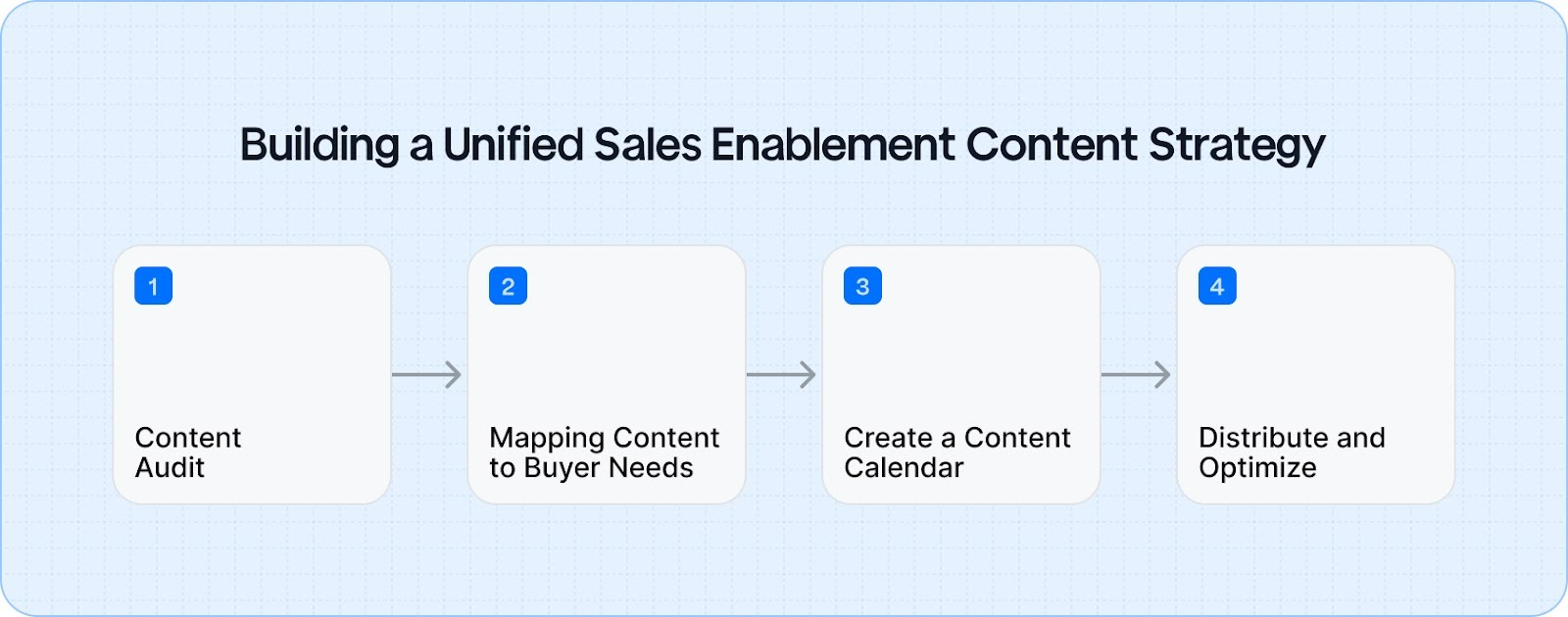
A well-structured content strategy is essential for aligning marketing and sales teams, ensuring that the right content reaches the right prospects at the right time.
Follow these steps to build a unified sales enablement strategy.
Step 1: Content Audit
Begin by reviewing your existing content. Identify which resources are performing well and which ones are not. This helps in understanding what resonates with your audience and what needs improvement or updating.
- Actionable Tip: Categorize your content into high-performing and underperforming sections. Repurpose or update old content to ensure it aligns with current buyer needs.
Step 2: Mapping Content to Buyer Needs
Align your content with different buyer personas and sales stages (awareness, consideration, decision). Each type of content should address specific pain points at each stage of the buyer’s journey.
- Actionable Tip: Create a content map that outlines which content should be used at each stage. For example, educational blog posts for the awareness stage and detailed case studies for the decision stage.
Step 3: Create a Content Calendar
Plan your content creation based on when your prospects are most likely to need it. Align the release of new content with sales campaigns, product launches, or industry events to ensure maximum relevance and impact.
- Actionable Tip: Schedule content based on seasonal trends, industry events, and key product features, ensuring your sales team has content ready for specific times of the year.
Step 4: Distribute and Optimize
Use content management systems (CMS) to organize and distribute content easily to your sales team. Make sure content is readily accessible and track its usage to see what works best in converting leads.
- Actionable Tip: Encourage your sales team to provide feedback on which content they use the most, allowing you to refine and improve your content library over time.
Technology’s Role
Easy-to-use tools like HubSpot, Salesforce, and Google Drive help automate and organize your content distribution. These tools allow seamless sharing, content tracking, and performance analysis to optimize content use.
Actionable Tip: Leverage CRM tools to analyze which content drives the highest conversion rates and ensure that your sales team has real-time access to high-impact content.
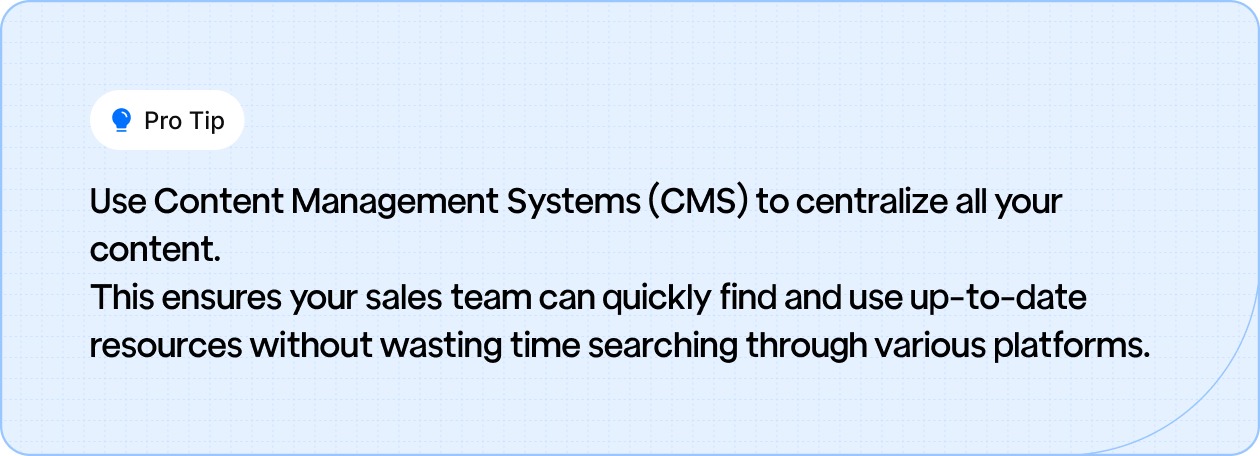
Optimizing Content for Sales Impact: Best Practices and Tips
Creating content that drives results for your sales team requires more than just putting together a few materials.
It’s about delivering the right content at the right time and in the right way. Here’s how to optimize your content to make sure it actually supports your sales efforts.
Tailor Content to Buyer Needs
Your content needs to speak directly to the buyer’s pain points at each stage of the buying process.
Rather than offering generic information, make sure the content is specific to the buyer’s challenges and how your product provides a solution.
- Key Action: Create content based on detailed buyer personas, focusing on specific issues that your product can solve.
- Why It Matters: Tailored content helps the buyer see your product as the solution to their problem, rather than just another option in the market.
Personalization at Scale
While personalized content is key, it can be difficult to create for each individual buyer. Fortunately, modern tools allow you to scale this personalization without losing its impact.
By using automation and CRM tools, you can deliver personalized content at every touchpoint, such as email and product demos.
- Key Action: Use CRM tools or AI-driven platforms to personalize emails and follow-ups based on the prospect’s previous interactions with your content.
- Why It Matters: Personalization at scale increases engagement and helps build stronger connections with leads.
Real-Time Sales Support
Sales teams often need content at a moment’s notice, during a call with a prospect or while in the middle of a demo.
Ensuring that your sales team has immediate access to the right materials can make all the difference between closing a deal and losing a lead.
- Key Action: Implement a content management system (CMS) that’s mobile-friendly and easily accessible during sales calls and meetings.
- Why It Matters: Speed and convenience in content access give sales reps the confidence to engage prospects effectively, without delays or distractions.
Measuring and Tracking Content Marketing and Sales Enablement Success
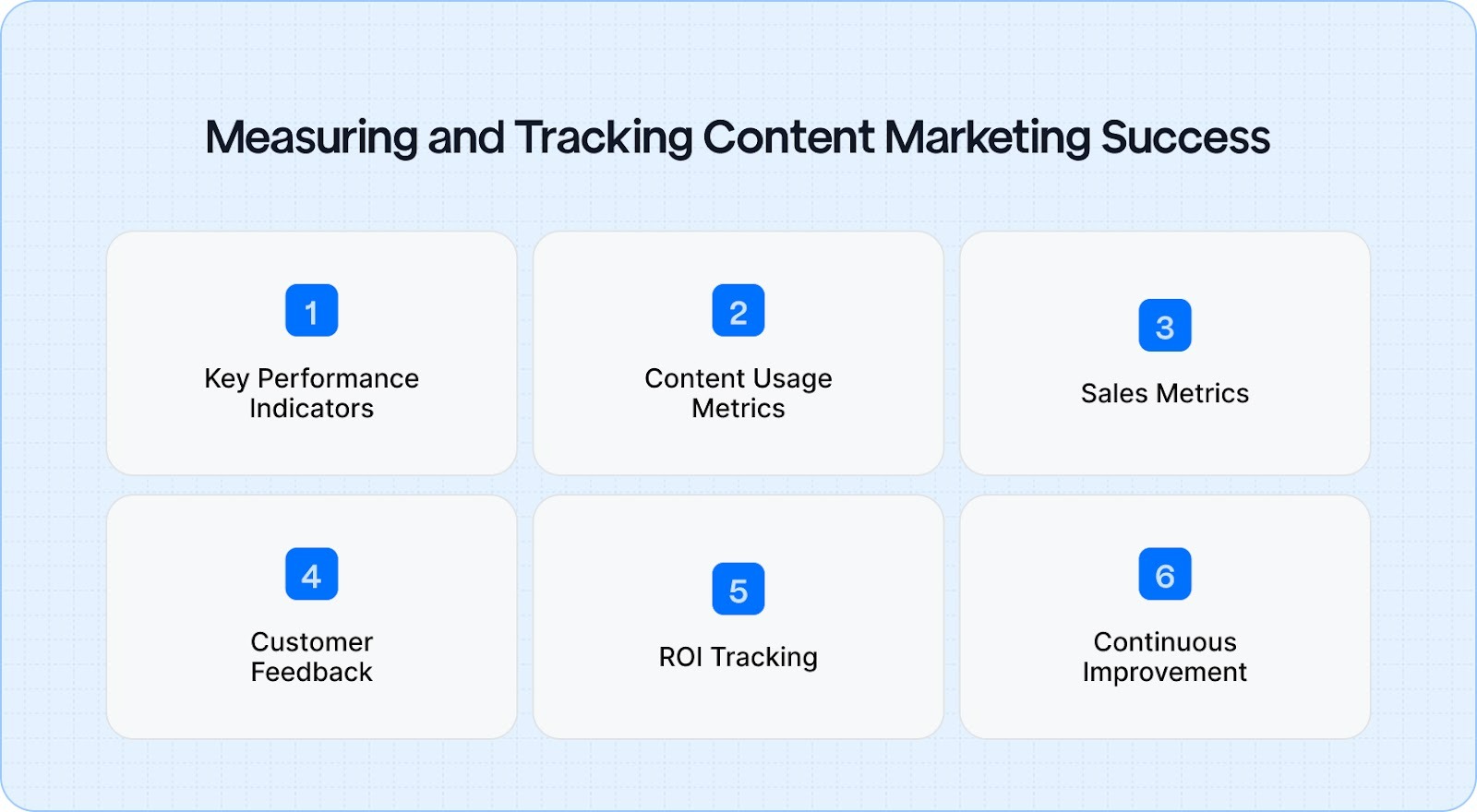
Tracking the success of your content helps refine your strategy. Here’s how to measure if your content is delivering the results you want.
- Key Performance Indicators (KPIs)
KPIs like lead generation, conversion rates, and engagement help track content success.
Actionable Tip: Focus on metrics like conversion rates and lead quality to assess content effectiveness.
- Content Usage Metrics
Track how often and which content is used by your sales team. This helps identify what’s working and what needs improvement.
Actionable Tip: Use CMS tracking to see which content gets the most engagement from your team.
- Sales Metrics
Metrics like win rates and conversion rates show how well content helps move prospects to a sale.
Actionable Tip: Compare deals that used specific content versus those that didn’t to see what’s driving success.
- Customer Feedback
Feedback from sales teams and prospects can highlight which content is resonating and what needs refinement.
Actionable Tip: Collect feedback regularly to understand what content works best in different sales situations.
- ROI Tracking
Measuring ROI helps you understand if content is delivering value relative to the investment.
Actionable Tip: Track revenue generated by content-driven leads alongside production costs to gauge ROI.
- Continuous Improvement
Adjust your content strategy based on performance data. Regular updates keep your content relevant and effective.
Actionable Tip: Conduct quarterly content reviews to optimize based on data.
Overcoming Common Barriers to Effective Content Marketing & Sales Enablement Alignment
Aligning content marketing and sales can be challenging. Here are some common barriers and how to overcome them.
Key Challenges:
- Siloed Teams: Marketing and sales teams often work separately, leading to misalignment in goals and messaging.
- Content Accessibility: Sales teams may struggle to quickly find and use the content they need.
Solutions to Overcome These Barriers:
- Build Open Communication: Encourage regular check-ins between sales and marketing teams. This keeps both teams aligned on goals and ensures content meets the needs of both parties.
- Invest in Technology: Use platforms like CRM or content management systems (CMS) to streamline content access. These tools help sales teams quickly find relevant materials and enable better collaboration between departments.
- Implement Feedback Loops: Create a process where sales teams provide regular feedback on content. This helps marketing adjust content based on what’s working in the field, improving its effectiveness over time.
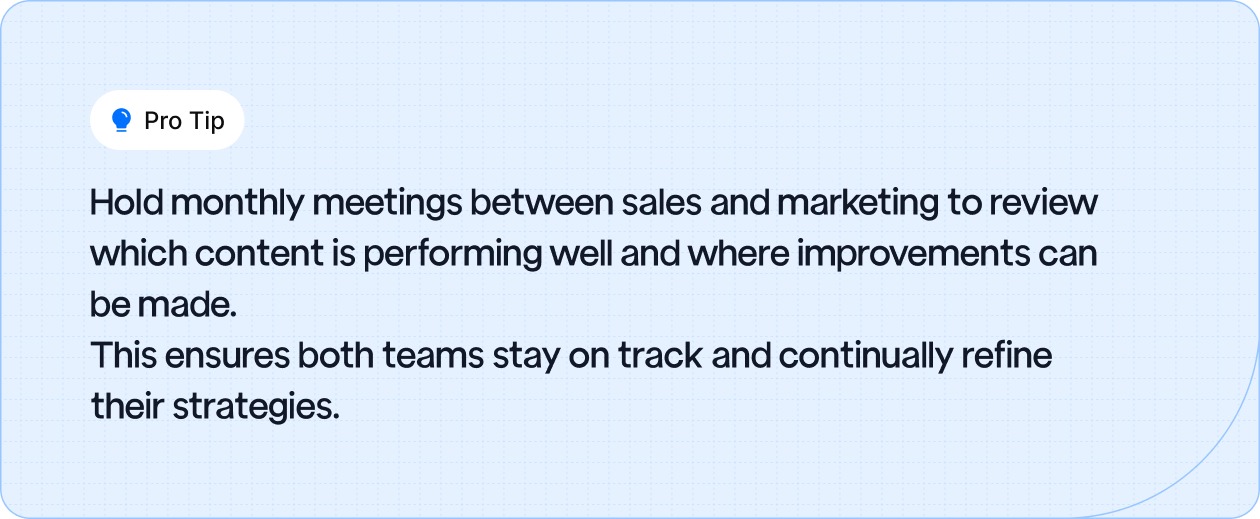
Enhance Your Sales Enablement Content Strategy
Aligning content marketing with sales enablement is essential for improving sales performance.
When your content is tailored to buyer needs, easily accessible by your sales team, and continuously optimized, you create a smooth sales process that drives results.
Key Takeaways:
- Content marketing and sales enablement need to work together to effectively engage and convert prospects.
- Optimizing content for each stage of the buyer’s journey helps move leads through the funnel.
- Regular collaboration between sales and marketing teams ensures content remains relevant and effective.
Ready to enhance your sales enablement content strategy?
FAQs
Q1. What’s the difference between content marketing and sales enablement?
A1. Content marketing focuses on creating valuable content to attract and educate potential customers. Sales enablement equips your sales team with the tools and resources they need to engage effectively with these prospects.
Q2. How can content marketing help my sales team?
A2. By providing educational materials like blog posts, videos, and case studies, content marketing helps your sales team engage prospects early in the buyer's journey, building trust and addressing their needs before direct sales efforts begin.
Q3. What types of content should be included in a sales enablement strategy?
A3. Effective sales enablement content includes:
- Product sheets
- Case studies
- Pitch decks
- Competitive battlecards
- Sales playbooks
These materials help sales teams address specific buyer needs and make their pitches more effective.
Q4. How do content marketing and sales enablement work together?
A4. Content marketing attracts and educates leads, while sales enablement ensures your sales team has the resources to convert these leads into customers. Together, they create a seamless and efficient sales process.
Q5. What are the key performance indicators (KPIs) for measuring success?
A5. Important KPIs include:
- Lead generation
- Conversion rates
- Customer acquisition cost (CAC)
- Lifetime value (LTV)
- Sales cycle length
Tracking these metrics helps assess the effectiveness of your content strategy and sales efforts.
Q6. How can I align my sales and marketing teams effectively?
A6. Foster open communication through regular check-ins, invest in shared tools like CRM systems, and implement feedback loops where sales teams provide input on content effectiveness. This alignment ensures both teams work towards common goals.
Q7. What are the common barriers to effective content marketing and sales enablement alignment?
A7. Key challenges include siloed teams and difficulty accessing content. Overcome these by encouraging regular communication between sales and marketing, investing in technology to streamline content access, and implementing systems for continuous feedback.














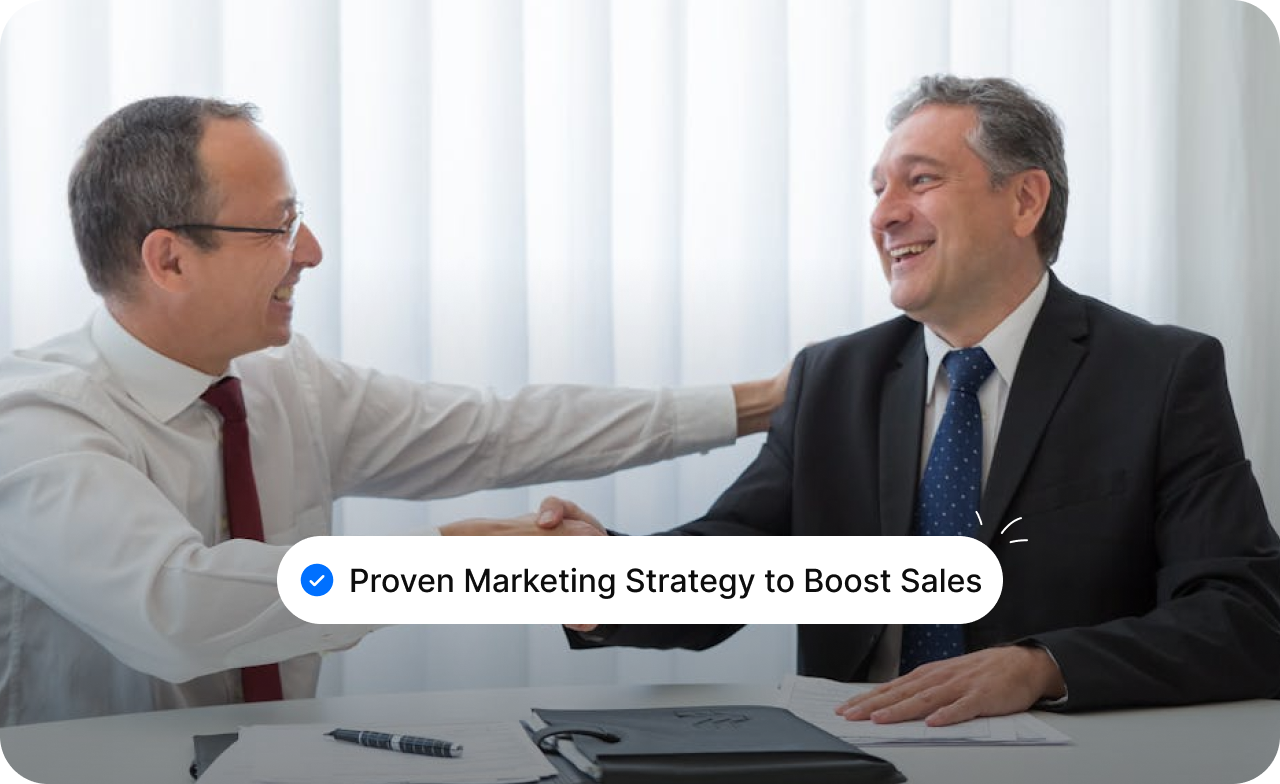





.webp)



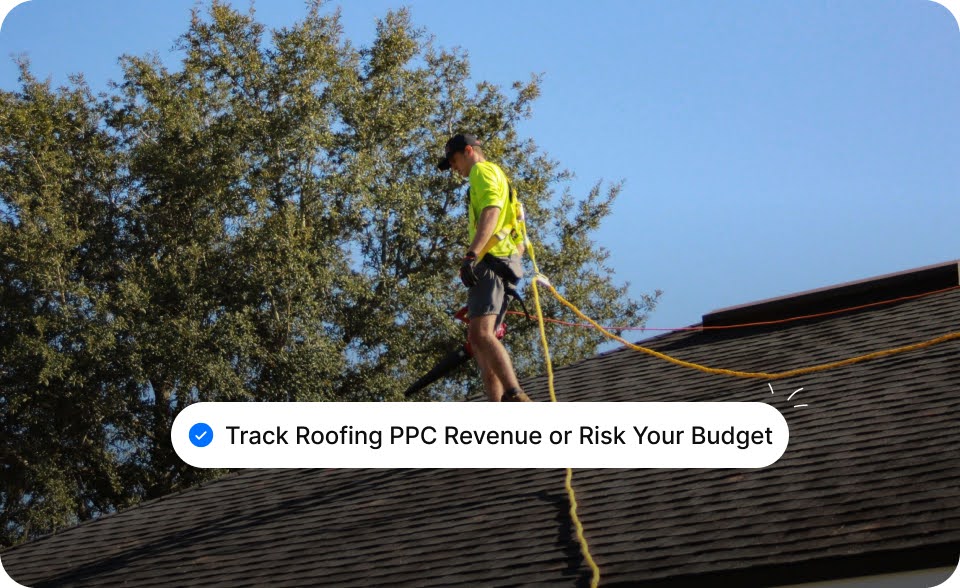




.webp)
.svg)


.svg)
.svg)
.svg)







.svg)